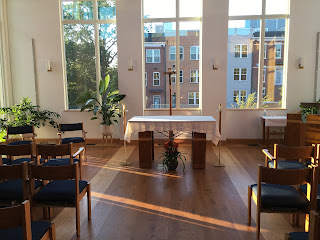If we were meeting back in New York, today we would be celebrating the feast of Mother Teresa, Saint Teresa of Kolkata as she now is. But her feast has not made it into Washington’s calendar. So instead, we are celebrating a Votive Mass – the Votive Mass for Religious Vocations.
In the Gospel we just heard [Luke 4:31-37], Jesus came to Capernaum on a Sabbath and drove out a demon. In Judaism, the sabbath is the great day of joy and freedom. What more fitting day to do a miracle! What more fitting day to drive out a demon! Gathered in their synagogue on the sabbath to hear the old stories of what God had done in the past to free and save them, the people unexpectedly got - not just to hear, but to see - God freeing and saving them anew. In so doing, Jesus shows the true nature of God’s kingdom, freeing us all from the demonic powers that can keep us captive.
In our time, someone like Mother Teresa appeared as an unexpected intrusion in the ultra-cynical, ultra-skeptical second half of the 20th century. In first-century Capernaum, Jesus also appeared somewhat unexpectedly, driving out demons with his astonishing authority that gripped the crowd then and still holds us spellbound.
We all know from pastoral experience that, when anyone who seems in any way strange shows up, anxiety arises as no one knows what to expect next. The man possessed by the demon was strange, in the usual sense. But Jesus turned out to be stranger still and even more unpredictable – challenging those there to recognize what God is doing here and now, to recognize (as Saint John XXIII famously said) “the hidden guidance of divine providence in the present course of events.”
We notice also how, once forced out of him, the demon could do the possessed man no further harm. That man, that day, experienced what Saint Paul [1 Thessalonians 4:13-18]expressed more generally for all of us – that God did not destine us for wrath, but to gain salvation, from salvation’s one and only source, Jesus Christ.
And how do we respond to that? The Capernaum crowd reacted with astonishment and responded by spreading the news. That’s a start, a good start. But Paul, who had done a lot of news-spreading himself, challenges us to the next step. Therefore encourage one another and build one another up.
Sometimes, we may be tempted to think that we have done enough when we spread the good news, give the word a voice. But then what?
In actual fact, most of our work – as a parish priest for 25 years, I would say almost all my work – has been about that next step, encouraging and building up, building Church in a contentious world where its presence is increasingly fragile.
(Whenever I hear those words of Saint Paul, I am reminded of Bruce Nieli back in 1981 inviting me to follow Hecker’s call to build Church!) Of course, that was also Saint Francis’s call some six centuries earlier. Is there anyone in this business, past or present, from the Pope going to Mongolia to this group gathered here, whose call it isn’t?
But how do we do this? Do we do this all across the board? Do we encourage one another (while there is still time, as Hebrews says [Hebrews 3:13])? Do we encourage one another and so build together?
The Church may be a mystery. But she is not mysterious. The Church, the ongoing building and repair of which is our ongoing job, is part and parcel of our present reality, which may still be more demon-possessed than we care to contemplate. What divides the world also divides the Church – divides and wounds, wounds us deeply.
If we aspire to be, in actual fact, that communion of saints – that image that so attracted Isaac Hecker to the Church – that communion of saints that we profess to believe in, then we have to take the communion part much more seriously, as an antidote to the division and distress we absorb from the world around us. For God did nor destine us for wrath.
Homily, Opening Mass, Paulist Fathers' General Council Meeting, the Paulist House of Studies, Washington, DC, September 5, 2023.


No comments:
Post a Comment